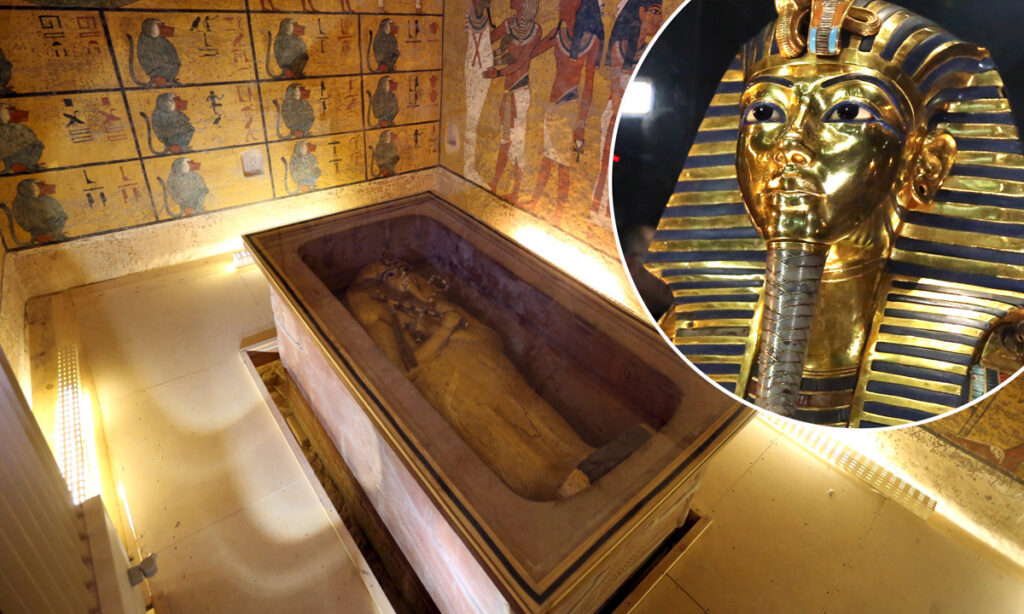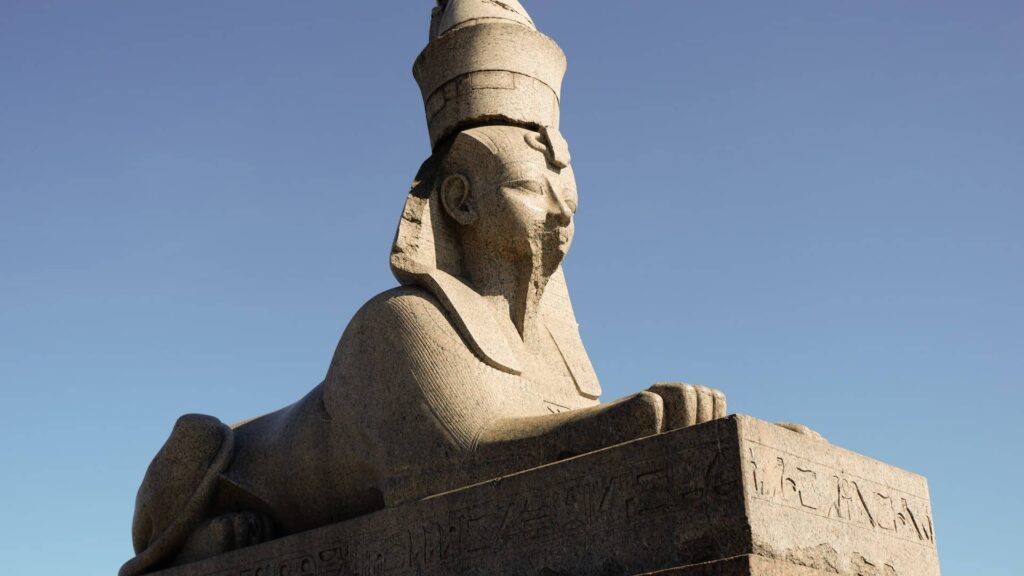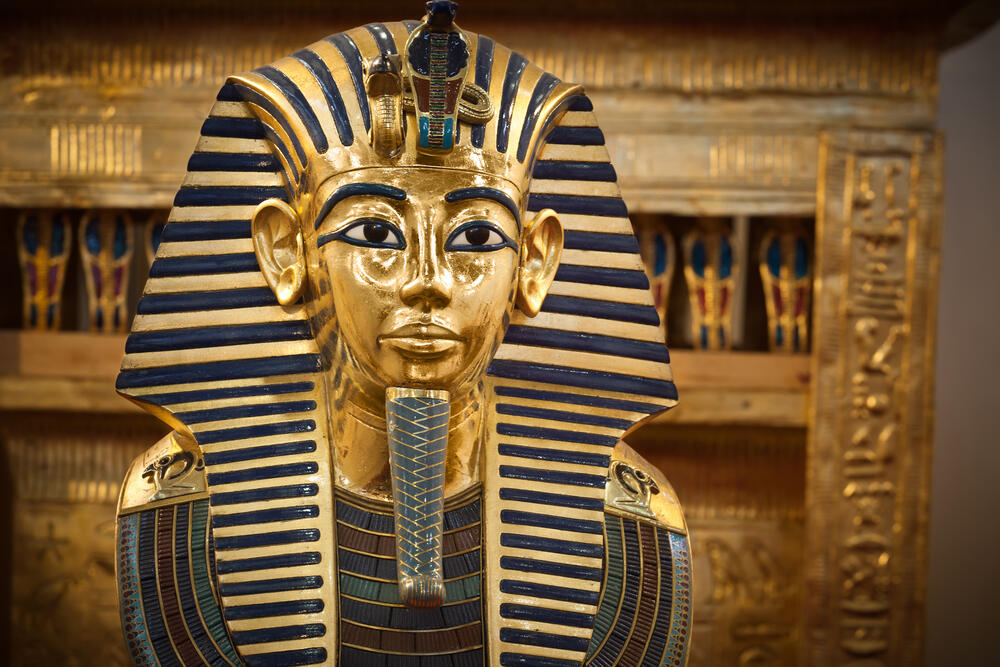Facts About Tutankhamun
The Curse of Tutankhamun

Also known as the “Curse of the Pharaohs,” is a popular legend that has surrounded the discovery and excavation of the tomb of Tutankhamun, an ancient Egyptian pharaoh. The curse is said to bring death or misfortune to anyone who disturbs the resting place of the pharaoh. Let’s explore some interesting facts about the curse and separate fact from fiction:
Discovery of Tutankhamun’s Tomb
: The tomb of Tutankhamun, located in the Valley of the Kings in Luxor, Egypt, was discovered by British archaeologist Howard Carter on November 4, 1922. It was a remarkable find, as the tomb was mostly intact and filled with a wealth of precious artifacts.
The “Curse” Inscription

: The notion of a curse on the tomb originated from an inscription found on the door of the tomb. It read, “Death will slay with his wings whoever disturbs the peace of the pharaoh.” This inscription, however, was a common warning found on many ancient Egyptian tombs to deter grave robbers.
The Media Sensation
The story of the curse captured the imagination of the public and the media, leading to sensationalized reports of mummies and ancient spirits seeking revenge on those who disturbed the tomb. Newspapers exaggerated the stories, creating an atmosphere of fear and intrigue.
Lord Carnarvon’s Death: One of the most well-known incidents linked to the curse was the death of Lord Carnarvon, who funded the excavation. He died on April 5, 1923, a few months after the tomb’s discovery, due to complications from a mosquito bite. His death fueled the belief in the curse, even though he wasn’t present when the tomb was opened.
Other Alleged Deaths
Several other members of the excavation team, as well as individuals connected to the tomb’s opening, reportedly suffered untimely deaths or misfortunes. These incidents further contributed to the legend of the curse.

Natural Causes and Coincidences
Most of the deaths attributed to the curse can be attributed to natural causes, accidents, or illnesses. Many of the “cursed” individuals were already in poor health, and their deaths were unrelated to any supernatural force.
Skeptical Perspectives
Many scholars and archaeologists dismiss the curse as a myth and believe that the deaths and misfortunes can be explained through rational and natural reasons. They argue that the “curse” is a combination of sensationalism, coincidences, and an overactive imagination.
Tutankhamun’s Resting Place
Despite the curse legend, Tutankhamun’s tomb itself remained undisturbed for more than 3,000 years. The ancient Egyptians took significant measures to protect and secure their tombs, which ultimately helped preserve the pharaoh’s resting place.
Modern Scientific Studies
In recent years, studies have been conducted to examine the possibility of toxic molds or bacteria within the tomb that could have caused health issues for those who entered. However, no conclusive evidence linking these factors to the alleged curse has been found.
In conclusion, the Curse of Tutankhamun is a fascinating legend that has captured the world’s imagination for decades. While the deaths and misfortunes associated with the curse make for compelling stories, they are often explainable by natural causes and coincidences. As with many historical myths, separating fact from fiction can help us better understand the true historical significance of Tutankhamun’s tomb and its remarkable treasures.
Howard Carter’s Journal
Howard Carter, the archaeologist who discovered the tomb, kept a detailed journal during the excavation. In his writings, there is no mention of him believing in any curse or feeling that supernatural forces were at work. Instead, he was excited about the remarkable artifacts and historical significance of the find.
“Curse Tablets”: Some of the deaths linked to the curse were based on hearsay and rumors rather than documented evidence. For example, there were claims that ancient Egyptian “curse tablets” were found in the tomb. These tablets were supposed to invoke evil spirits to punish tomb robbers. However, no such tablets were actually discovered in Tutankhamun’s tomb.
Visitors and Survivor
Contrary to the popular belief that everyone who entered the tomb succumbed to the curse, many people who were present during the opening of the tomb lived for years afterward. For instance, Howard Carter himself lived for another 17 years after the discovery.
The Cursed Box
Another story related to the curse involves a “cursed box” sent by Carter to a friend. Allegedly, the friend and his family experienced tragedies after receiving the box. However, this claim has been widely debunked as a later invention with no evidence to support it.
Museums and Exhibitions
After the artifacts from Tutankhamun’s tomb were taken to museums around the world for exhibitions, there were reports of visitors experiencing strange occurrences and bad luck. These stories added to the mystique of the curse, but they were likely exaggerated or merely coincidental incidents.
Respect for Ancient Burials
The notion of a curse surrounding Tutankhamun’s tomb has also led to increased awareness and respect for ancient burial sites and artifacts. The legend highlighted the importance of preserving such historical treasures and treating them with care and reverence.
“Mummy’s Curse” in Pop Culture
The Curse of Tutankhamun has had a significant impact on popular culture. It inspired numerous books, movies, and TV shows, perpetuating the myth and cementing its place in modern storytelling.
Scientific Investigations
In an effort to demystify the curse, scientists have conducted various studies and examinations of Tutankhamun’s mummy and the tomb’s contents. Modern technologies, such as DNA analysis, have shed light on the pharaoh’s lineage and health, offering a more scientific perspective on his life and death.
In the end, the Curse of Tutankhamun remains an enduring legend that captures the fascination of people worldwide. While there were certainly unfortunate events surrounding the tomb’s discovery and subsequent exhibitions, they can largely be explained by natural causes and historical circumstances. The mystery and allure of ancient Egypt, however, continue to captivate and spark curiosity about the enigmatic world of the pharaohs.
“The Mummy” (1932)
The idea of a mummy’s curse gained further popularity after the release of the classic horror film “The Mummy” in 1932, starring Boris Karloff. Although the movie was not directly related to Tutankhamun, it contributed to the general fascination with mummies and curses during that era.
Tutankhamun’s Death
Tutankhamun himself had a short and somewhat mysterious reign. He became pharaoh at the age of nine and died around the age of 18 or 19. The cause of his death is still debated among scholars, with theories ranging from an accident to illness to foul play.
Rumors of Inscriptions
There were rumors that inscriptions on the walls of Tutankhamun’s tomb foretold dire consequences for those who entered. However, such inscriptions have not been found in the tomb. The curse inscription on the door, as mentioned earlier, was a standard warning found on many ancient Egyptian tombs.
Media Hype and Sensationalis
The media played a significant role in perpetuating the curse legend. Newspapers of the time, seeking to boost sales and create sensational stories, exaggerated incidents and linked them to the curse, further fueling public fascination.
Ancient Egyptian Beliefs
While there is no historical evidence of a specific “curse” associated with Tutankhamun’s tomb, ancient Egyptians did hold beliefs in protecting their burial sites and the souls of the deceased. They believed that proper rituals and offerings were essential to ensure a smooth journey to the afterlife.
The “Curse of the Pharaohs” Concept: The idea of a curse associated with disturbing the resting places of pharaohs predates Tutankhamun’s discovery. In 1699, the French writer and traveler Paul Lucas wrote about a supposed curse after visiting the tombs of the Valley of the Kings.
The Curse’s Impact on Archaeology
The Curse of Tutankhamun, despite being a legend, had both positive and negative effects on the field of archaeology. It raised awareness about the importance of preserving historical sites and respecting ancient cultures, but it also perpetuated misconceptions and made it challenging for archaeologists to counter the curse narrative.
Howard Carter’s Team
Howard Carter’s excavation team included a diverse group of people, from archaeologists to laborers. Many of them lived long lives after their involvement in the discovery of the tomb, which contradicts the idea that everyone who entered the tomb met a tragic fate.
Exhibitions of the Treasures: The traveling exhibitions of Tutankhamun’s treasures, also known as the “Tutankhamun exhibitions,” have been viewed by millions of people worldwide. These exhibitions have sparked wonder and interest in ancient Egypt’s history and culture.
Modern Excavations
The fascination with Tutankhamun’s tomb and the legend of the curse have inspired further archaeological excavations and research in the Valley of the Kings and other ancient Egyptian sites, leading to new discoveries and a deeper understanding of ancient Egyptian civilization.
In conclusion, the Curse of Tutankhamun is a captivating and enduring legend that has left an indelible mark on popular culture and our perception of ancient Egypt. While the curse itself is likely a product of media hype and exaggerated stories, the discovery of Tutankhamun’s tomb remains one of the most significant archaeological findings in history, shedding light on the opulence and mystery of ancient Egyptian civilization.
Lord Carnarvon’s Canine Connection: Lord Carnarvon, who funded the excavation, was a dog lover. He had two pet terriers that he brought to Egypt with him. It is said that one of the terriers was present at the tomb’s opening, and it died shortly afterward. This led some to speculate that the curse also affected animals, though it’s more likely that the dog’s death was due to the harsh Egyptian climate or some other natural cause.
The Media’s Influence
As the story of the curse spread, newspapers embellished and sensationalized the incidents, attributing any misfortune, illness, or even death that occurred to the curse. The media frenzy played a significant role in perpetuating the legend and shaping public perception.
Death Mask of Tutankhamun
One of the most iconic artifacts found in Tutankhamun’s tomb is his golden death mask. The mask is an exquisite portrayal of the young pharaoh’s features, and it is believed to have been placed directly on his mummy’s face. The death mask is now displayed at the Egyptian Museum in Cairo.
Financial Impact
The discovery of Tutankhamun’s tomb had a profound financial impact on Egypt. The artifacts found in the tomb became a significant source of revenue through exhibitions and tourism, boosting the country’s economy.
The Carter Curse Letters
Some believers in the curse claimed that Carter himself was affected by it. Allegedly, a series of letters warning about the curse were found among Carter’s papers after his death. However, these letters have never been produced or authenticated, and their existence remains questionable.
Tutankhamun’s Tomb Robbed? Despite the alleged curse, Tutankhamun’s tomb was not immune to looting. In ancient times, after his burial, the tomb was broken into and robbed at least twice. Fortunately, the burial chamber remained mostly untouched, allowing the stunning discovery in 1922.
Death by Murder or Poisoning: In the years following the discovery of the tomb, some writers and conspiracy theorists suggested that Tutankhamun was murdered or poisoned. However, scientific examinations of his mummy have not supported these claims, and it is generally believed that his death was most likely due to natural causes.
“The Curse of the Pharaohs” Revisited: The Curse of Tutankhamun inspired the idea of a more general “Curse of the Pharaohs.” Some people believed that any ancient Egyptian tomb disturbed by archaeologists would bring misfortune. However, not all Egyptologists subscribe to this belief, and many continue to explore ancient sites without fear of a curse.
Tutankhamun’s Afterlife
The ancient Egyptians believed in an afterlife and followed elaborate burial practices to ensure the pharaoh’s successful journey to the realm of the dead. The discovery of Tutankhamun’s tomb provided valuable insights into their burial customs and religious beliefs.
The Eternal Popularity of Tutankhamun: Over the years, Tutankhamun has remained one of the most famous and recognizable pharaohs in history. His legacy endures through the global fascination with ancient Egypt and its rich cultural heritage.
The legend of the Curse of Tutankhamun continues to capture the imagination and intrigue of people worldwide. While the curse itself is widely considered a myth, the story surrounding the discovery of Tutankhamun’s tomb remains a remarkable tale of archaeological triumph and the enduring allure of ancient civilizations.
